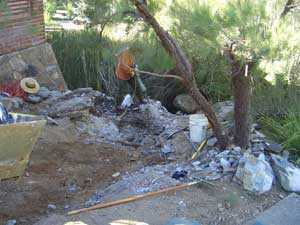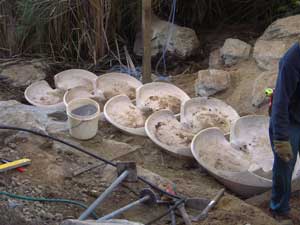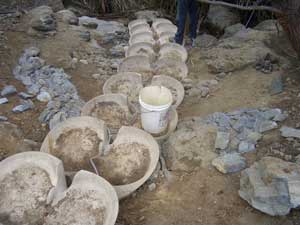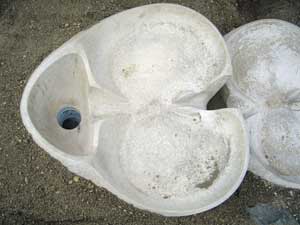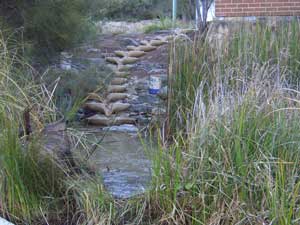The Friends Cascades
Water Sculpture
a project near the Visitor Centre, funded by the Friends of the ANBG
 |
|
A cascade sculpture based on natural water movement re-invigorates water at the Australian National Botanic gardens…
Much has been said about sustainable and environmentally friendly water use on a large and small scale. At the Australian National Botanic Gardens in Canberra, a Flowform sculpture serves as an interesting reminder to people that recycling and re invigorating water can be both functional and appealing to the senses!
Many people are attracted to the sound and then the mesmerizing rhythm and water movement…what we are hoping is that people may be inspired by the sculpture and see such ‘waterwise’ ideas as an interesting landscaping option...particularly when such a structure can be incorporated as part of the landscape.
How it all came about…
Back in 2003, there was a waterfall that flowed into the pond below, however a substantial structural leak formed and was deemed irreparable. This, compounded by subsequent drought and water conservation priorities lead to the waterfall being switched off completely. Since then the water stagnated and pond life deterioted.
Australian National Botanic gardens staff prepared a project proposal to both restore the water cascade and provide ideal conditions for micro-organisms to improve and restore water quality and pond life…with the funding provided by the Friends of the gardens and design / construction by ANBG staff, we now have the ‘friend’s cascades’.
Often Flowforms are set up on an ‘industrial’ looking frame above the ground, when used commercially for treating effluent, grey water recycling, stirring bio-dynamic preparations and so on. ‘We wanted to have the cascade fit snugly into the immediate landscape and so constructed the series of Flowforms using the slope to advantage, a stylised version of a creek bed if you like’.
The Flowforms are set up at varying angles to give different effects, some strongly pulsing, others a very gentle movement.
Topping up the pond from our water supply was not an option, so we had to ensure the system was self sustaining in terms of replacing any water loss through evaporation. There is runoff collected from the adjacent building that tops up the pond, as well as an option using rain water tank storage for topping up in long dry periods.
What are Flowforms?
Flowforms are vessels that seek to emulate the swirls and vortices of the mountain stream, enabling water to re oxygenate, revitalise and rejuvenate itself, to bring it back to its more natural state. Flowforms generally form a cascade of water that flows into a tank or pool. The water can be recirculated as many times as desired.
Flowforms are set up in a cascade, through which water flows, from one to the next. The Flowforms' shape coaxes the water (which would otherwise flow along the axis of the cascade by gravity) into eddies and vortices, a pulsating figure of eight pattern in each form before it drops into the next a mimicking of the action water undergoes in its natural undisturbed flow in, say, a stream, as opposed to captive water in typical channels or pipes.
Flowforms take many sizes and shapes, with certain common characteristics: a smaller entry "bowl" which receives water from the source or the Flowform above, from which it flows into two larger basins where the figure of eight movement takes place, then an outlet through which the flow drops to the next Form. The size and positioning of the entry bowl, its outlet, the larger basins and their outlet and the shaping of the surfaces over which the water flows is what does the "coaxing" referred to above.
The secret of the Flowform lies in it creating this "figure of 8" movement in the water - the lemniscate. Oxygen is folded into the water, and thus ideal conditions are created for micro-organisms to help break down waste in a natural and gentle way, therefore Flowforms enhance water naturally.
What can Flowforms be used for
Flowforms are used extensively in Agriculture and Aquaculture, Stirring Biodynamic and Organic fertilizers, processing farm effluents and vitalizing dam water. They can be used as a means of purifying and oxygenating water in water treatment and bio-remediation contexts, including constructed wetlands for sewage and dairy farm effluent ponds. They are also commonly used as garden features, public sculptures, biological purification, food processing, interior air-conditioning and as therapeutic installations.
Ideally Flowforms can be both sculptural & functional.
In Australia, the world’s driest continent precious water needs to be used sensibly, water recycling & improvement using Flowforms is a logical environmentally friendly way of helping achieve this.
Watering gardens and commercial plantings is often quite difficult due to the lack of water. On many farms and small holdings, Grey Water (shower, kitchen, and laundry water) is wasted. A Grey Water system complemented with Flowforms can completely recycle this waste water and prepare it for the garden or agriculture.
Such a system has many advantages. The grease trap collects the grease and oils ready for recycling back into the compost heap, and needs to be emptied occasionally - maybe once per year, depending on the number of people in the family and the types of food consumed. An easy to use high quality plastic trap is commercially available from wholesale plumbing supplies.
Flowforms, depending on the type and size, require a flow rate of 12 to 250 litres of water per minute. You will therefore need a small pump to recirculate the water through the Flowforms this can be solar powered. The Flowforms can be easily landscaped into your garden to provide the tranquil sounds or rhythmical water falls and cascades, and with nearby planting, create a beautiful setting for relaxation.
Grey water treatment areas are easily disguised as part of your garden and with little thought and work can indeed become quite a beautiful feature.
Flowform Background and History
Flowforms originated in the 1960s from the work of Theodore Schwenk, George Adams and John Wilkes. Wilkes saw that the secret of water’s vitality lay in its rhythmical movement. The As Schwenk had observed rhythmical motions are evident in many water phenomena: rising and falling tides, the repeated crashing of waves on a beach, the alternating left and right curves of a river’s meanders, even the Earth’s hydrological cycle. But the orderly form exists only fleetingly, and then quickly dissolves. Apparently, water can manifest its potential of creating orderly forms within itself only momentarily, and then returns to the state the poet Novalis called “sensitive chaos”, the name Schwenk chose for his book on fluid movement.
Would it be possible, Wilkes wondered, to design a sequence of forms through which water could fulfil its capacity to manifest orderly metamorphic process, to create artistically what he calls an “organ of metamorphosis” for water? Such a sequence of forms, he argued, might bring to physical expression the delicate potential for ordered movement that appears to be inherent in the nature of water.
Thus the Flowform came into being, after much experimentation and painstaking modifications – the water lemniscate was born – i.e. the movement of water in a figure of 8 rhythms that has been the basis of this amazing revitalising effect on water.
These notes have been re-edited and assembled from much written and verbal information on flow forms and all comments are not necessarily endorsed by the Australian National Botanic gardens.
David Taylor 20/8/2006
Other References and information include
Carde, M. (1990), ‘Flowforms : Rx for dying water’, Design Spirit, Fall 1990.
Glazebrook, T. (2003), ‘Art or nature ? Aristotle, restoration ecology, and flowforms’, Ethics & the Environment, vol. 8, no. 1, pp. 22-36.
Kilner, PJ. (2006), ‘Science in culture’, Nature, vol. 442, issue 7098, pp. 28-29.
[Discoveries in flowform design made by the author while studying with John Wilkes led on to studies of flow through the heart.]Kilner, PJ, Yang, G-Z, Wilkes, AJ, Mohladdin, RH, Firmin, DN & Yacoub, MH (2000), ‘Asymmetric redirection of flow through the heart’, Nature, vol. 404, pp. 759-761.
Riegner, M & Wilkes, J. (1988), ‘Art in the service of nature: the story of flowforms’, Orion Nature Quarterly, vol. 7, no. 1, pp. 50-57.
Riegner, M & Wilkes, J. (1998), ‘Flowforms and the language of water’, in, D Seamon & A Zajonc (eds.) Goethe’s way of science: a phenomenology of nature, State University of New York Press, Albany, NY, pp. 233-252. [A revised version of the 1988 article by Riegner & Wilkes in Orion Nature Quarterly.]
Schwenk, T. (1996), Sensitive chaos: the creation of flowing forms in water and air, rev. 2 nd edn., Rudolf Steiner, London.
Thomas, N. (1983), ‘Flowform rhythms’, Science Forum (Anthroposophical Society in Great Britain), no. 4, pp. 16-19.
Wilkes, J. (1992), ‘Flow design research relating to flowforms’, in A Wolpert & W Forward (eds.) Chaos, rhythm and flow in nature, Floris Books, Edinburgh, (The Golden Blade vol. 46), pp. 72-84.
Wilkes, J. (1994), ‘The flowform method’, Transforming Art, vol. 4, no. 2, pp. 41-48.
Wilkes, AJ, (2003), Flowforms: the rhythmic power of water, Floris Books, Edinburgh.
Websites
John Wilkes company website, Virbela Flowforms
http://www.virbelaflowforms.anth.org.uk/New Zealand company Design for Life and the Ecology Design Research Institute
http://www.flow-forms.com/Phil Sedgman at Living Water Flowforms in Byron Bay, NSW.
http://www.livingwaterflowforms.com/
Acknowledgements
Phil Sedgman at Living Water Flowforms, who made the flowforms for the project and assisted with providing much information included above.
![Director of National Parks [logo]](../../../../../images/dnp_90px.gif)






